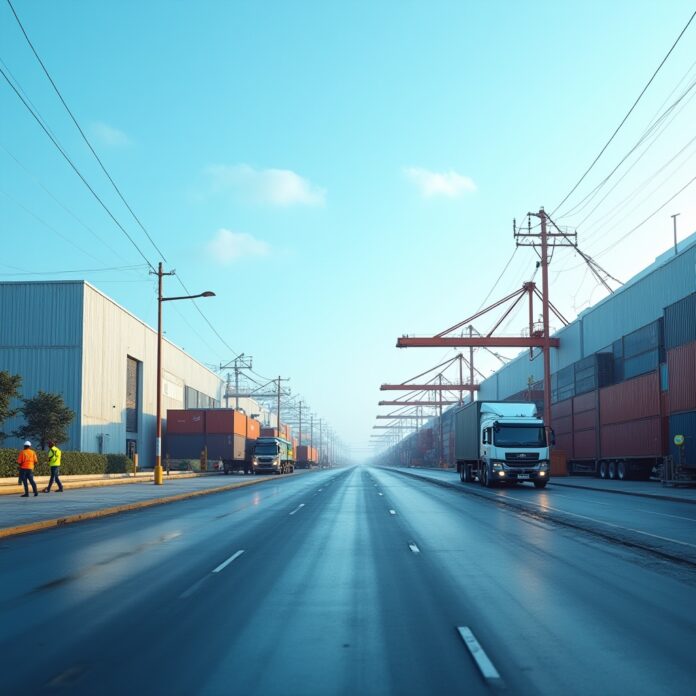Nigeria’s gleaming $1.5 billion Lekki Deep Sea Port stands at the center of a political maelstrom. As its container volumes explode—leaping from 54,289 TEUs in 2023 to 222,000 TEUs by June 2025—a bitter truth surfaces: this engineering marvel isn’t just moving cargo; it’s unmasking decades of regional inequities. Deputy Chief Operating Officer Daniel Odibe’s ambitious target of 500,000 TEUs by December 2025 represents a staggering 740% surge from its debut year, but this growth spotlights the rotting wharves of Calabar, the scandal-plagued dredging of Warri, and the shallow potentials of Port Harcourt. What began as Nigeria’s pride now fuels geopolitical tensions, exposing how infrastructure can divide as fiercely as it unites.
Lekki’s Ascent: Anatomy of a Maritime Juggernaut
Capacity vs. Reality: The Untapped Potential
Behind the celebratory headlines, Lekki operates at just 20% of its 1.2 million TEU capacity—a paradox of underutilization amid explosive growth. Despite processing 222,000 TEUs in the first half of 2025, the port’s towering cranes await fuller ships. Yet the trajectory stuns: from 287,000 TEUs in 2024 to 500,000 projected by year-end, driven by transshipment to Togo, Ghana, Abidjan, and landlocked neighbors.
The Efficiency Edge
What makes global giants like Maersk and CMA CGM flock here? Automated gates slash truck processing to 1.1 hours. Post-Panamax cranes with twin-lift capability move containers like chess pieces. Vessels turnaround in 48 hours—not days—while dwell time averages 16 days. Crucially, Lekki’s 16.5-meter depth welcomes ships carrying 18,000 containers, impossible for rivals like Apapa with their 13-meter limitations. The Federal Government has approved further dredging to 17 meters, targeting 19 meters eventually to accommodate even larger vessels.
Economic Catalysts
The port’s surge intertwines with Nigeria’s macroeconomic shifts. Management confirms the naira’s stabilization reversed early setbacks from subsidy removal, reigniting import volumes. Weekly calls by COSCO and ZIM/GSL cement Lekki’s global credibility, while its Vehicle Booking System’s integration with Lagos’ E-call-up promises seamless cargo evacuation. Transshipment operations now actively redirect cargo to Benin Republic, Togo, and Ghana, positioning Nigeria as an unexpected regional hub.
The Powder Keg: How Lekki’s Rise Exposes Regional Rifts
The “Two Nigerias” Maritime Divide
As Lekki thrives, eastern ports decay. Calabar—gateway to 16 northern states and Niger Republic—suffers chronic under-dredging despite ₦20 billion in disputed contracts. Warri’s silted channels block barges, while Onitsha’s inland port languishes, strangling Southeast commerce. This fuels resentment: regions producing over 90% of Nigeria’s foreign exchange lack deep-sea ports, creating a dangerous economic asymmetry.
Strategic Fault Lines
Lagos already handles over 70% of Nigeria’s cargo, creating catastrophic single-point failure risks if conflict or disaster blocks access. Federal officials cite eastern piracy to justify underinvestment, yet regional leaders counter that “neglect breeds insecurity.” Before Lekki, Nigerian cargo transshipped via Lomé or Tema, adding $400 per container in costs and 14-day delays—a leakage now reversing as Lekki captures neighboring traffic.
Transshipment Wars
Lekki’s expansion into Ghana and Abidjan’s traditional turf ignites regional rivalry. Togo’s Lomé Port—long West Africa’s transshipment king—now faces direct competition as Lekki reroutes cargo to Benin Republic and landlocked nations. The African Continental Free Trade Area’s promise of intra-African trade hangs in the balance: will Nigeria’s gain become its neighbors’ loss or stimulate healthy competition?
Political Firestorm: The Battle Lines Drawn
Regional Advocacy Escalates
Northern Governors amplify demands for Calabar’s revival, noting “Cotonou is farther than Calabar for Niger Republic trade.” Simultaneously, Southeast groups decry Lekki’s perceived monopoly while Onitsha port starves. Their manifesto frames port access as constitutional equity, not charity, highlighting how maritime infrastructure has become a litmus test for national unity.
Federal Pushback
Nigerian Ports Authority Managing Director Mohammed Bello-Koko dismisses “death of other ports” as fallacy, framing Lekki as a hub destined to feed regional spokes like Warri. Security arguments resurface—eastern waters face greater piracy threats—but critics note security investments historically follow commerce rather than precede it, creating self-fulfilling neglect cycles.
Terminal Operators’ Warning
Industry spokesman Bolaji Akinola sounds alarms about Lekki’s looming congestion disaster without rail integration, evidenced by pre-dawn three-hour crawls from Ikoyi. He urges immediate barge deployment and rail connections to avert “Apapa 2.0” gridlock, emphasizing that port efficiency extends beyond quayside operations to hinterland connectivity.
Blueprints for Equitable Growth
Resurrect the Eastern Gateways
Fast-track transparent dredging of Calabar to 16 meters, leveraging its natural link to northern markets and Niger Republic. Simultaneously activate Onitsha’s inland port with River Niger barges to serve Southeast commerce, decongesting Lagos-bound trucks. These steps would transform neglected assets into thriving alternatives.
Evacuation Infrastructure
Complete the 25-kilometer Seventh Axial Road by 2028 to slash truck transit from 4.5 hours to 90 minutes. More critically, immediately connect Lekki to national rail networks—the linchpin for sustainable cargo movement. The Nigerian Shippers’ Council emphasizes barge operations as non-negotiable for Lekki’s survival, urging partnerships with European experts for financing and technology transfer.
Security as Shared Priority
Deploy African Maritime Forces Summit strategies to secure eastern waters, making Calabar viable. Leverage EU-Safe Seas Africa partnerships for Gulf of Guinea patrols, demonstrating that security investments can enable economic inclusion rather than excuse regional marginalization.
Incentivize Decentralization
Offer tax breaks for shipping lines using Warri or Calabar, and establish special economic zones near Port Harcourt to attract export industries. Tariff harmonization and legislative support for waterway heavy goods movement would rebalance national logistics flows, easing Lagos’ unsustainable burden.
Beyond Rivalry—A Networked Future
Lekki’s crane lights gleam like beacons, but their glow reveals shadows across Nigeria’s maritime landscape. As management champions transshipment to Abidjan, the real test isn’t reaching 500,000 TEUs—it’s ensuring Calabar’s cranes don’t rust in darkness. The solution isn’t throttling Lekki’s rise; it’s cloning its blueprint: automate Warri, dredge Calabar, unleash Onitsha. Nigeria’s coastline spans 853 kilometers—only 25% is commercially operational. Imagine the federation when the rest awakens.
A nation’s maritime strategy cannot anchor in one port. True hub status emerges when tides lift all vessels—from Lagos to the Niger Delta. The December 2025 deadline looms: Lekki’s container target must coincide with concrete commitments to regional port revival. Only then can Nigeria transform zero-sum rivalry into a rising tide of shared prosperity.


